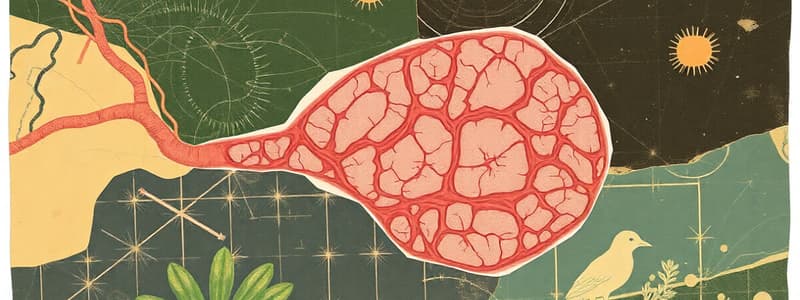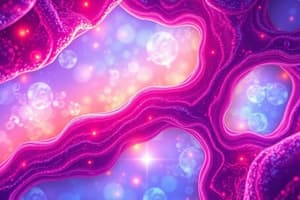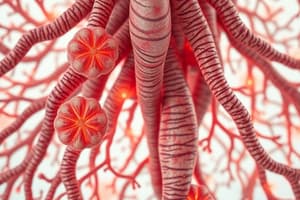Podcast
Questions and Answers
Which type of epithelial tissue is responsible for protection and mucus secretion?
Which type of epithelial tissue is responsible for protection and mucus secretion?
- Simple Squamous
- Stratified Squamous
- Simple Cuboidal
- Simple Pseudostratified (correct)
What is the primary function of loose connective tissue?
What is the primary function of loose connective tissue?
- Contraction and movement
- Secretion of hormones
- Transmission of nerve impulses
- Support, elasticity, and diffusion (correct)
Which of the following is NOT a type of muscle tissue?
Which of the following is NOT a type of muscle tissue?
- Cardiac
- Skeletal
- Smooth
- Glial (correct)
What is the function of myelin in the nervous system?
What is the function of myelin in the nervous system?
What is the function of dendrites in a neuron?
What is the function of dendrites in a neuron?
Which type of neuron carries sensory information from the body to the central nervous system?
Which type of neuron carries sensory information from the body to the central nervous system?
Which level of organization in the animal body is responsible for carrying out related steps in a major physiological process?
Which level of organization in the animal body is responsible for carrying out related steps in a major physiological process?
Which of the following is NOT a task of organ systems in the animal body?
Which of the following is NOT a task of organ systems in the animal body?
Which type of receptor is responsible for detecting damaging stimuli that the brain interprets as pain?
Which type of receptor is responsible for detecting damaging stimuli that the brain interprets as pain?
Which of the following accurately describes the role of the exoskeleton in animals?
Which of the following accurately describes the role of the exoskeleton in animals?
What is the primary function of the microtubules found in smell receptor hairs?
What is the primary function of the microtubules found in smell receptor hairs?
Which of the following is NOT a characteristic of a hydrostatic skeleton?
Which of the following is NOT a characteristic of a hydrostatic skeleton?
Why is sensory adaptation beneficial for animals?
Why is sensory adaptation beneficial for animals?
What is the relationship between calcium and the vertebrate skeleton?
What is the relationship between calcium and the vertebrate skeleton?
Which of the following statements accurately differentiates between compact and spongy bone tissue?
Which of the following statements accurately differentiates between compact and spongy bone tissue?
Which of the following is a characteristic that distinguishes the skeletal systems of invertebrates from vertebrates?
Which of the following is a characteristic that distinguishes the skeletal systems of invertebrates from vertebrates?
What is homeostasis primarily responsible for?
What is homeostasis primarily responsible for?
Which method is used in homeostasis to bring a variable back to its set point?
Which method is used in homeostasis to bring a variable back to its set point?
What characterizes an endotherm?
What characterizes an endotherm?
What distinguishes a homeotherm from a heterotherm?
What distinguishes a homeotherm from a heterotherm?
Which of the following accurately describes positive feedback?
Which of the following accurately describes positive feedback?
Why is feedforward important in homeostatic regulation?
Why is feedforward important in homeostatic regulation?
Which characteristic is true for ectotherms?
Which characteristic is true for ectotherms?
What is the main function of negative feedback in homeostasis?
What is the main function of negative feedback in homeostasis?
What is the role of the hypothalamus in thermoregulation?
What is the role of the hypothalamus in thermoregulation?
How do ectotherms primarily obtain heat energy?
How do ectotherms primarily obtain heat energy?
What physiological change occurs during thermal acclimatization?
What physiological change occurs during thermal acclimatization?
What happens during vasodilation?
What happens during vasodilation?
What is torpor characterized by?
What is torpor characterized by?
Which process occurs when there is a fall in core temperature?
Which process occurs when there is a fall in core temperature?
During which condition does the skin primarily function as an organ of heat transfer?
During which condition does the skin primarily function as an organ of heat transfer?
What occurs to the set point in many birds and mammals during cooler conditions?
What occurs to the set point in many birds and mammals during cooler conditions?
What is the primary function of bones in the skeletal system?
What is the primary function of bones in the skeletal system?
Which type of muscle is responsible for voluntary movements and is attached to bones?
Which type of muscle is responsible for voluntary movements and is attached to bones?
What occurs at the neuromuscular junction?
What occurs at the neuromuscular junction?
What role do myofibrils play in muscle contraction?
What role do myofibrils play in muscle contraction?
How is strength versus speed determined in muscle attachment?
How is strength versus speed determined in muscle attachment?
What is the function of troponin and tropomyosin in muscle contraction?
What is the function of troponin and tropomyosin in muscle contraction?
Which muscle type is characterized by involuntary control and is found in the heart?
Which muscle type is characterized by involuntary control and is found in the heart?
What initiates the muscle action potential during muscle contraction?
What initiates the muscle action potential during muscle contraction?
What primarily distinguishes electrical synapses from chemical synapses?
What primarily distinguishes electrical synapses from chemical synapses?
What is the role of calcium in synaptic transmission?
What is the role of calcium in synaptic transmission?
Which of the following is characteristic of ionotropic receptors?
Which of the following is characteristic of ionotropic receptors?
How do chemical synapses primarily communicate signals?
How do chemical synapses primarily communicate signals?
What is the main function of the presynaptic cell in synaptic transmission?
What is the main function of the presynaptic cell in synaptic transmission?
What is a characteristic of graded potentials in neurons?
What is a characteristic of graded potentials in neurons?
What role do neurotransmitters play in the nervous system?
What role do neurotransmitters play in the nervous system?
Which aspect of the nervous system evolution primarily reflects increasing complexity?
Which aspect of the nervous system evolution primarily reflects increasing complexity?
Flashcards
Homeostasis
Homeostasis
Regulation of the body's internal environment near a stable level.
Negative Feedback
Negative Feedback
A process that returns a variable back to a set point to minimize changes.
Positive Feedback
Positive Feedback
A process that moves a variable away from a set point to amplify effects.
Feedforward
Feedforward
Signup and view all the flashcards
Endotherm
Endotherm
Signup and view all the flashcards
Ectotherm
Ectotherm
Signup and view all the flashcards
Homeotherm
Homeotherm
Signup and view all the flashcards
Heterotherm
Heterotherm
Signup and view all the flashcards
Skeletal System
Skeletal System
Signup and view all the flashcards
Muscles
Muscles
Signup and view all the flashcards
Types of Vertebrate Muscle
Types of Vertebrate Muscle
Signup and view all the flashcards
Skeletal Muscles
Skeletal Muscles
Signup and view all the flashcards
Neuromuscular Junction
Neuromuscular Junction
Signup and view all the flashcards
Action Potential
Action Potential
Signup and view all the flashcards
Calcium in Muscle Contraction
Calcium in Muscle Contraction
Signup and view all the flashcards
Sliding Filament Theory
Sliding Filament Theory
Signup and view all the flashcards
Thermoregulation
Thermoregulation
Signup and view all the flashcards
Hypothalamus
Hypothalamus
Signup and view all the flashcards
Thermal Acclimatization
Thermal Acclimatization
Signup and view all the flashcards
Vasoconstriction
Vasoconstriction
Signup and view all the flashcards
Vasodilation
Vasodilation
Signup and view all the flashcards
Torpor
Torpor
Signup and view all the flashcards
Functions of Nervous System
Functions of Nervous System
Signup and view all the flashcards
Synapses
Synapses
Signup and view all the flashcards
Presynaptic cell
Presynaptic cell
Signup and view all the flashcards
Postsynaptic cell
Postsynaptic cell
Signup and view all the flashcards
Electrical Synapse
Electrical Synapse
Signup and view all the flashcards
Chemical Synapse
Chemical Synapse
Signup and view all the flashcards
Neurotransmitters
Neurotransmitters
Signup and view all the flashcards
Acetylcholine
Acetylcholine
Signup and view all the flashcards
Sensory Adaptation
Sensory Adaptation
Signup and view all the flashcards
Taste and Smell Receptors
Taste and Smell Receptors
Signup and view all the flashcards
Nociceptors
Nociceptors
Signup and view all the flashcards
Electroreceptors
Electroreceptors
Signup and view all the flashcards
Hydrostatic Skeleton
Hydrostatic Skeleton
Signup and view all the flashcards
Exoskeleton
Exoskeleton
Signup and view all the flashcards
Bone Tissues
Bone Tissues
Signup and view all the flashcards
Calcium Regulation
Calcium Regulation
Signup and view all the flashcards
Cells
Cells
Signup and view all the flashcards
Tissues
Tissues
Signup and view all the flashcards
Organs
Organs
Signup and view all the flashcards
Organ Systems
Organ Systems
Signup and view all the flashcards
Epithelial Tissue
Epithelial Tissue
Signup and view all the flashcards
Connective Tissue
Connective Tissue
Signup and view all the flashcards
Muscle Tissue
Muscle Tissue
Signup and view all the flashcards
Nervous Tissue
Nervous Tissue
Signup and view all the flashcards
Study Notes
General Concepts
- Animals are non-human members of the animalia kingdom.
- Animals are multicellular eukaryotes that lack cell walls.
- Animals are heterotrophs, which means they obtain energy by consuming other organisms.
- Animals are generally motile, meaning they can move.
- Animals can reproduce sexually or asexually.
- Animals have nerves and muscles.
Animal Characteristics
- Multicellular eukaryotic organisms
- Lack cell walls
- Heterotrophic
- Motile
- Sexual or asexual reproduction
- Possess nerves and muscles
Animal Diversity
- Diverse species
- Diverse habitats
- Diverse characteristics
Animal Origins
- Common ancestor of all animals = colonial flagellated protist from Precambrian.
- Similarity to modern colonial flagellated species and morphological and molecular evidence support this theory.
Animal Classification
- Classification of animals is based on common ancestry and shared characteristics.
- The level of detail in classification reflects the closeness of the evolutionary relationship between organisms.
Tissue Stability in Animals
- Animal cells lack cell walls, thus stability is achieved by extracellular junctions within tissues to maintain cell shape, structure, and function rather than by a cell wall.
- Types of junctions include anchoring, tight, and gap junctions. Anchoring junctions: connect proteins to join cells together. Tight junctions: prevent passing through cells. Gap junctions: allow cell-cell communication and ion exchange.
Terms From This Lecture
- Protostomes: Spiral cleavage, mouth from blastopore, schizocoelom
- Deuterostomes: Radial cleavage, anus from blastopore, enterocoelom
- Acoelomate: No body cavity
- Pseudocoelomate: Fluid-filled cavity between endoderm and mesoderm
- Coelomates: Fluid-filled cavity between intestines and body wall
- Radial Symmetry: Divided equally by any longitudinal plane
- Bilateral Symmetry: Divided along a vertical plane in the middle
- Segmentation: Repeated structures along anterior-posterior axis.
Embryonic Development
- Fertilization (zygote) --> Cleavage (morula) --> Blastula --> Gastrulation (gastrula)
- Zygote cleavage = division of cells early in development without significant growth
- Morula develops into a hollow sphere of single-layered cells called a blastula.
- Gastrulation = process of cell movement and differentiation into three germ layers, ectoderm, mesoderm, and endoderm
- Blastula invaginates, differentiating the germ layers.
Germ Layers
- Ectoderm (outer layer), mesoderm (middle layer), endoderm (inner layer)
- Germ layers differentiate into tissues and organs.
- Diploblastic animals have two germ layers (ectoderm and endoderm)
- Triploblastic animals have three germ layers (ectoderm, mesoderm, and endoderm).
Animal Body Plans
- Influences on animal body plans include embryonic development pattern, germ cell layers, body symmetry, and body cavity type.
Sexual Reproduction
- Most animals undergo some form of sexual reproduction.
- Germ line cells undergo meiosis to produce haploid gametes.
- Gametes fuse (fertilization) to form a diploid zygote.
Asexual Reproduction
- Examples include budding in hydra, fragmentation in echinoderms, and parthenogenesis in insects.
Protosomes
- Exhibit spiral cleavage
- Each cell's developmental path is determined as the cell is produced.
- Each blastomere cannot become a complete organism by itself.
Deuterostomes
- Exhibit radial cleavage
- Developmental path is undetermined
- Each cell can form a complete organism by itself.
Homeostasis
- Regulation of the body's internal environment at or near a stable level.
- Homeostasis is important for maintaining optimal physiological performance.
- Homeostasis regulates a physiological variable within a narrow range around a set point.
Mechanisms of Homeostasis
- Feedback loops-Negative feedback, positive feedback, and feedforward mechanisms are used.
- Negative feedback loops return a variable back to set point.
- Positive feedback loops move a variable away from the set point and are used to increase or decrease a process quickly.
- Feedforward mechanisms involve anticipating future needs and adjusting physiology in advance.
Thermoregulation
- Maintaining body temperature at an optimal level for physiological performance.
- Endotherms obtain heat from internal reactions, while ectotherms obtain heat from the external environment.
Temperature Regulation - Endotherms
- Changes in skin temperature cause changes in core temperature, triggering thermoregulatory responses in endotherms.
Sensory Systems
- Sensory systems detect information about the environment.
- Sensory inputs are converted to electrical signals, transmitted to the CNS and integrated to help the organism maintain homeostasis.
- Types of receptors include mechanoreceptors (detect mechanical stimuli), photoreceptors (detect light).
- Chemoreceptors (detect chemicals)
- Nociceptors (detect pain)
- Electroreceptors (detect electrical fields)
- Magnetoreceptors (detect magnetic fields)
Sensory Adaptation
- The effect of a stimulus is reduced if it continues at a constant level.
- Sensory receptors adapt to maintain responsiveness to changing conditions.
Nervous System
- Neurons communicate information between body parts and glial cells support neurons and maintain ion balance.
- Action potentials generate electrical signals by the movement of ions across the neuron membrane.
- Synapses are the sites where neurons communicate with other neurons or effectors.
- Neurotransmitters relay information from one neuron to the next.
Compound Eyes
- Contain many faceted visual units
- Light is focused by a transparent cornea and crystalline cone
- Brain receives a motion-sensitive mosaic image
Single Lens Eyes
- Light enters through the cornea
- Lens concentrates light onto photoreceptors (retina)
- Iris adjusts pupil size, and accommodation occurs, adjusting lens shape for distant or near vision
The Ear
- Pinna focuses sound waves
- Sound waves pass through the middle ear (malleus, incus, stapes) to the inner ear (cochlea, organ of Corti)
- Hair cells in Organ of Corti send signals to the brain
- The human ear also plays a role in balance and orientation
Animal Skeletal System
- Animal skeletons provide support, locomotion, and protection.
- Types of skeletons include exoskeletons (e.g., insects, crustaceans), endoskeletons (e.g., vertebrates), and hydrostatic skeletons (e.g., worms).
- Bone tissue provides support and calcium storage.
- Calcium homeostasis is regulated by endocrine negative feedback loops.
Muscle Tissue Types
- Skeletal, cardiac, and smooth muscle
- Skeletal muscles move the body, and cardiac muscle forms the heart.
- Smooth muscle lines the walls of blood vessels and other internal organs.
Animal Locomotion and Skeletons
- Skeletal Muscles and how they work to produce movement in conjunction with bones
- Muscles (contraction based on interactions between support filaments)
- Types of vertebrate muscle; Skeletal, cardiac, and smooth muscles in detail.
Studying That Suits You
Use AI to generate personalized quizzes and flashcards to suit your learning preferences.




